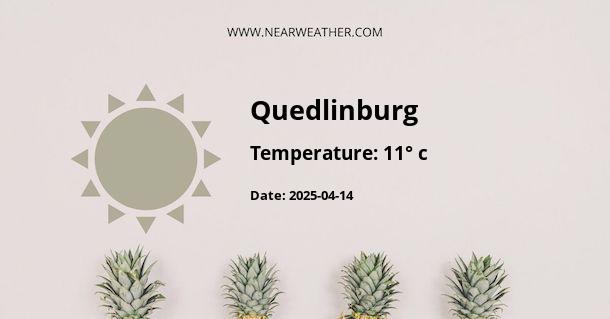Climate and Weather in Quedlinburg, Germany
Quedlinburg, located in the Harz Mountains in the Saxony-Anhalt region of Germany, experiences a temperate climate with distinct seasons throughout the year. The town's location in the northern part of the country and its elevation contribute to its unique weather patterns. Let's explore the climate and weather conditions in Quedlinburg throughout the year.
Temperature and Seasonal Variation
Quedlinburg experiences four distinct seasons: spring, summer, autumn, and winter. The average annual temperature in Quedlinburg is around 9 degrees Celsius (48 degrees Fahrenheit), with noticeable variations between seasons.
| Month | Average Temperature (°C) |
|---|---|
| January | -1 |
| February | 0 |
| March | 3 |
| April | 7 |
| May | 12 |
| June | 15 |
| July | 17 |
| August | 17 |
| September | 13 |
| October | 9 |
| November | 4 |
| December | 1 |
The warmest months in Quedlinburg are July and August, with average temperatures around 17 degrees Celsius (63 degrees Fahrenheit). The coldest months are January and February, with average temperatures around -1 degree Celsius (30 degrees Fahrenheit). Quedlinburg experiences pleasant temperatures during spring and autumn, making these seasons ideal for outdoor activities.
Precipitation and Rainfall
Quedlinburg receives a moderate amount of rainfall throughout the year, with the highest precipitation occurring during the summer months. The town experiences an average of 700 millimeters (27.6 inches) of rainfall annually.
The distribution of rainfall is relatively even throughout the year, with slightly higher amounts during the summer months. The wettest months in Quedlinburg are July and August, with an average of 80 millimeters (3.1 inches) of rainfall per month. Winter months receive slightly less precipitation, with an average of 40-50 millimeters (1.6-2 inches) per month.
Snowfall
Due to its location in the Harz Mountains, Quedlinburg experiences snowy winters. Snowfall typically occurs from December to March, with January and February being the snowiest months. The town receives an average of 30-40 centimeters (11.8-15.7 inches) of snow annually.
The snowy landscapes create a picturesque atmosphere in Quedlinburg, attracting tourists who enjoy winter sports and the beauty of the surrounding mountains.
Sunshine Hours
Quedlinburg benefits from a moderate amount of sunshine throughout the year. The town receives an average of 1,600 hours of sunshine annually, with the highest number of sunshine hours occurring in the summer months.
The sunniest months in Quedlinburg are June and July, with an average of 200 hours of sunshine each. The winter months have fewer sunshine hours, with December being the least sunny month.
Wind Patterns
Quedlinburg experiences relatively calm wind conditions throughout the year. The town is shielded by the Harz Mountains, which help to reduce the impact of strong winds. However, gentle breezes from the surrounding areas can be felt, especially during the summer months.
Conclusion
Quedlinburg, Germany, offers a temperate climate with distinct seasons. Visitors can expect mild temperatures during spring and autumn, warm summers with moderate rainfall, snowy winters, and a moderate amount of sunshine throughout the year. The town's location in the Harz Mountains adds to its charm and provides opportunities for outdoor activities in every season.
A - Quedlinburg's Latitude is 51.783329 & Longitude is 11.150000.
A - Weather in Quedlinburg is 11° today.
A - Climate Conditions in Quedlinburg shows few clouds today.
A - Humidity in Quedlinburg is 85% today.
A - Wind speed in Quedlinburg is 7.52 km/h, flowing at 239° wind direction. today.
